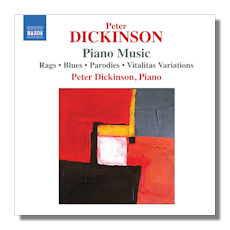
The Internet's Premier Classical Music Source
Related Links
- Dickinson Reviews
- Latest Reviews
- More Reviews
-
By Composer
-
Collections
DVD & Blu-ray
Books
Concert Reviews
Articles/Interviews
Software
Audio
Search Amazon
Recommended Links
Site News
 CD Review
CD Review
Peter Dickinson

Piano Music
- Wild Rose Rag (1985)
- Blue Rose (1979)
- Paraphrase II (1967)
- Concerto Rag (1980)
- Quartet Rag (1976)
- Vitalitas Variations (1957)
- Three Satie Transformations based on Gnossiennes (1970)
- Bach in Blue (2004)
- Hymn-Tune Rag (1985)
- Patriotic Rag (1986)
- Four piano Blues (1973)
- Five Diversions (1963)
Peter Dickinson, piano
Naxos 8.572654 79:34
Listed in order of presentation, written between 1963 and 2004, and recorded with piano solo from 1975 to 2010, these pieces have an interesting history. The first two were based on Edward MacDowell's "To a Wild Rose" and were the basis for Dickinson's Blue Rose Variations for Organ (Naxos 8.572169). "Paraphrase II" was based on some short choral pieces. "Concerto Rag" is a diatonic version of the rag featured in the composer's Piano Concerto. "Quartet Rag" was the basis for Dickinson's "String Quartet #2." The Vitalitas Variations, originally "Piano Variations," became a very successful ballet, choreographed and danced by Gloria Contreras, who wrote an account of this in her book What I have Learned from Balanchine: Diary of a Choreographer. Dickinson made an orchestration, and there was a chamber group version, but Dickinson says that the piano version suited the dance best. The "Three Satie Transformations" were originally for orchestra, with the first as a trumpet solo, the second shared by clarinet and cor anglais, and the third was a big band number. "Hymn-Tune Rag" comes from different sources, one of which the composer can no longer trace. "Patriotic Rag" was the basis for Dickinson's "London Rags" for Brass Quintet. "Four Blues" came from "American Trio," in turn reworked from a withdrawn piece called "Hymns, Blues and Transfomations." "Five Diversions," dedicated to Dickinson's wife, were transformed from clavichord, harpsichord and orchestral versions.
So much for the provenance of these works. They work just fine for piano, as their composer is a fine pianist. (He began as an organist, as it happens.) The rags, in the tradition of Scott Joplin, rather than that of Jelly Roll Morton, have a crisp rhythmic articulation. The blues are very gently played. Those from 1973 are marked "Extremely slow and quiet," "Very slow and intense," "Very quiet and intimate," and "Slow and sustained." These markings say it all; this is not to belittle them in any way. They are meditative and satisfying.
The three "Satie Variations" on that composer's Gnossiennes depart considerably from their models. The first is faster and the second slower than Satie would have it. The third is a very vigorous transformation, with a bass emphasis, that is very different from the spirit of the original. Similarly, "Bach in Blue" departs considerably from the beautiful first prelude in Bach's "48 Preludes and Fugues." Dickinson's added accompaniment was, on first hearing, rather disturbing to the ear of my wife, who plays this prelude frequently on the piano. The Five Diversions are light, and in different styles and moods indicated by clear designations as "Amiable," "Lyrical" (wonderfully mellow sounding), "Gently jazzy," "Quiet and dreamy," "Lively and brash."
The two long works, separated by ten years, have seven or eight movements each. The "Vitalitas Variations" has conventional tempo designations from "Lento" to "Vivace." I particularly enjoyed its first "Lento" and the second "Andante." The sections of "Paraphrase II" are differentiated only by metronome markings from 50 to 132; they are played without pause but are very sharply differentiated in tempo, style and mood, from quiet, limpid and meditative to fast and agitated. As one might expect of a work from 1967 the work includes some "serial workings," as well as canons, during which can hear clearly the differentiation between the right and left hand playing. The final section begins in an agitated way but calms down considerably towards the end.
Recommended.
Copyright © 2012, R. James Tobin





















